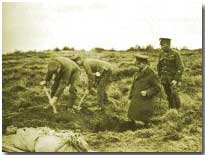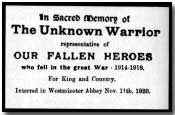Feature Articles - The Unknown Warrior
 The Great War did not officially end until June 1919 with the final signing
of the Treaty of Versailles. As part of the plan to mark the war's end
with a victory parade,
Lloyd George proposed a controversial scheme to
place 'a catafalque' somewhere along the route, where the marching troops
could salute the dead.
The Great War did not officially end until June 1919 with the final signing
of the Treaty of Versailles. As part of the plan to mark the war's end
with a victory parade,
Lloyd George proposed a controversial scheme to
place 'a catafalque' somewhere along the route, where the marching troops
could salute the dead.
Sir Edwin Lutyens was given two weeks to design a non-denominational shrine, made out of wood and plaster. It was Lutyens who suggested this structure be named the Cenotaph: the empty tomb.
It was the Cenotaph which most captured the public imagination during the victory celebrations on 19 July, and after the parade many of the bereaved laid wreaths there. It was evident that a more permanent monument was required, and Lutyens was commissioned to design a stone Cenotaph for the same site, which would be unveiled by the King on Armistice Day 1920.
 As
plans were being drawn up for a simple unveiling ceremony on November 11th
1920, there was a proposal that the body of an unknown soldier be returned
to England for burial at the same time.
As
plans were being drawn up for a simple unveiling ceremony on November 11th
1920, there was a proposal that the body of an unknown soldier be returned
to England for burial at the same time.
It is generally agreed that the original idea came from the vicar of Margate, the Reverend David Railton MC (pictured right), who had served as a padre in France in 1916. Years later he wrote:
I came back from the line at dusk. We had just laid to rest the mortal remains of a comrade. I went to a billet in front of Erkingham, near Armentieres. At the back of the billet was a small garden, and in the garden only six paces from the house, there was a grave. At the head of the grave there stood a rough cross of white wood. On the cross was written in deep black-pencilled letters, "An Unknown British Soldier" and in brackets beneath, "of the Black Watch". It was dusk and no one was near, except some officers in the billet playing cards. I remember how still it was. Even the guns seemed to be resting.
How that grave caused me to think. Later on I nearly wrote to Sir Douglas Haig to ask if the body of an "unknown" comrade might be sent home...
In 1920 he wrote to the Dean of Westminster Abbey, Doctor Ryle, who in turned made the suggestion to the government. Despite initial misgivings, it was realised that this one symbolic burial could stand for all the hundreds of thousands missing men with no known grave.
 There are a number of different versions of
how the selection
of the body was made, but according to the officer in charge
Brigadier-General Wyatt (writing in 1939) one body, identifiable only as a
British soldier, was exhumed from each of the four main battle areas, the
Aisne, the Somme, Ypres and Arras, on the night of 7 November and brought to
the chapel at St. Pol.
There are a number of different versions of
how the selection
of the body was made, but according to the officer in charge
Brigadier-General Wyatt (writing in 1939) one body, identifiable only as a
British soldier, was exhumed from each of the four main battle areas, the
Aisne, the Somme, Ypres and Arras, on the night of 7 November and brought to
the chapel at St. Pol.
Each body was covered with a Union Jack and placed on a stretcher. Those versions of the story which claim that the officer in charge was blindfolded, seem to be incorrect. Wyatt merely pointed to one of the bodies, which was placed in a coffin and the remaining three bodies were removed and reburied.
 The
following day the body was taken to Boulogne under escort where it was
placed in a coffin made of English oak, and a crusader-style sword presented
by the King was fixed to the coffin. On 9th November a French military
escort went with the body to Boulogne, where
Marshal Foch (above) paid his
own homage. British troops then took over guard duties and the body
crossed the Channel in the destroyer Verdun, receiving a Field
Marshal's nineteen gun salute on arrival at Dover. Crowds gathered at
every station on the way as the Unknown Warrior's train travelled north from
the Kent coat to London's Victoria station.
The
following day the body was taken to Boulogne under escort where it was
placed in a coffin made of English oak, and a crusader-style sword presented
by the King was fixed to the coffin. On 9th November a French military
escort went with the body to Boulogne, where
Marshal Foch (above) paid his
own homage. British troops then took over guard duties and the body
crossed the Channel in the destroyer Verdun, receiving a Field
Marshal's nineteen gun salute on arrival at Dover. Crowds gathered at
every station on the way as the Unknown Warrior's train travelled north from
the Kent coat to London's Victoria station.
The train thundered through the dark, wet, moonless night. At the platforms by which it rushed could be seen groups of women watching and silent, many dressed in deep mourning. Many an upper window was open and against the golden square of light was silhouetted clear cut and black the head and shoulders of some faithful watcher.
.... In the London suburbs there were scores of homes with back doors flung wide, light flooding out and in the garden figures of men women and children gazing at the great lighted train rushing past.
from the Daily Mail 11 November 1920
On the morning of 11 November the body of the Unknown Warrior was drawn to the Cenotaph on a gun carriage pulled by six black horses, followed by twelve distinguished pallbearers, including Haig, Beatty and French. Many of those who lined the streets watching the procession pass had been waiting all night.
 At
eleven o'clock - "the eleventh hour" - as Big Ben began to chime, the King
turned to face the Cenotaph and, by a touch on a button, released the flags
veiling the monument.
At
eleven o'clock - "the eleventh hour" - as Big Ben began to chime, the King
turned to face the Cenotaph and, by a touch on a button, released the flags
veiling the monument.
As the chimes died away, everyone fell silent for two minutes, and the Last Post sounded.
The solemn journey continued down Whitehall to Westminster Abbey where the nave was lined by 100 soldiers who had been awarded the Victoria Cross. The Royal Family had pride of place, but the congregation was primarily composed of widows and mothers who had lost sons. There was no foreign representation. The service was brief and according to The Times , 'the most beautiful, the most touching and the most impressive this island has ever seen....'
 The
first ever recordings made in the Abbey were taken of the ceremony by Major
Lionel Guest and Captain Merriman who sold the resulting discs for seven
shillings and sixpence (37p) each.
The
first ever recordings made in the Abbey were taken of the ceremony by Major
Lionel Guest and Captain Merriman who sold the resulting discs for seven
shillings and sixpence (37p) each.
The event touched the nation in a remarkable way with the Daily Mirror special edition, selling almost two million copies, a record for a single issue.
It had been planned that the grave of the Unknown Warrior would be closed after allowing a pilgrimage of three days. The organisers were taken completely by surprise by the response of the people, not only in London, but throughout Great Britain. Once the ceremony was finished the thousands of people who had lined the streets began to queue to pass the Cenotaph. Most of them had brought wreaths or bunches of flowers to place at the base of the memorial.
At least 40,000 people passed through the Abbey before the doors were closed at 11pm an hour later than the scheduled closure time and thousands more passed the Cenotaph. There were still long queues at midnight, and people continued to visit the site through the night.
Most impressive of all was the night scene in Whitehall. The vast sweep of the road was almost silent save for the ceaseless murmur of footsteps. Under the brilliant glare of the lamps that were softened by the foggy air the long, dark lines of people stretched from Trafalgar Square to the Cenotaph from whose base they could be seen vanishing in the distance, two narrow lines of slowly moving people separated by a wide pathway on which stood here and there vague figures of policemen on horseback.
from the Daily Mail 12 November 1920
The pilgrimage went on throughout the weekend, with Saturday bringing large numbers of pilgrims from outside London. The Daily Express told the story of two wounded soldiers who walked sixty miles to lay wreaths at the Cenotaph; they had both lost brothers in the war. There were pilgrims from Ireland, Scotland and Wales.
One policeman spoke of old women who had come from remote country villages to pay homage to the dead. "One old lady came from the far north of Scotland. She carried a bunch of withered flowers, and told me with tears in her eyes that the flowers came from a little garden which her boy had planted when he was only six."
from Daily Telegraph 12 November 1920
On Monday 15 November traffic began to move along Whitehall, but the great pilgrimage carried on. As buses passed the Cenotaph, the drivers slowed out of respect, and their passengers stood and removed their hats. Up to the time the grave was closed on 18th November an estimated 1,250,000 people visited the Abbey, but the pilgrimage continued long afterwards, with the space enclosing the grave remaining filled with flowers and other tributes for almost a year.
It was probably the greatest public outpouring of emotion that Britain had ever seen.
Further reading on this subject:
Ronald Blythe, The Age of Illusion (1963)
David W.Lloyd, Battlefield Tourism (1998)
Michael Gavaghan, The Story of the Unknown Warrior
(1997)
David Cannadine, Aspects of Aristocracy
(1994)
Article contributed by Mike Roden, website Aftermath.
'Kitchener's Army' comprised Men recruited into the British Army a result of Lord Kitchener's appeal for volunteers.
- Did you know?
